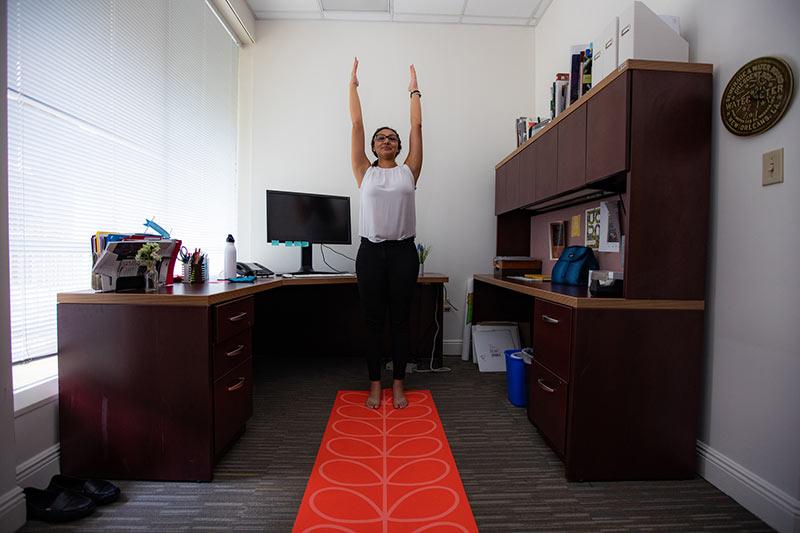Tips to transitioning to the ‘new now’ in work and school
As the entire Tulane community adjusts to changing work and learning environments, along with the continued uncertainty of the pandemic, it’s natural to experience some anxiety, said Tonya Hansel, professor at the School of Social Work and Doctor of Social Work program director.
“When we don’t know and we can’t plan, we have some apprehension, and that’s a safety mechanism,” she said.
And that apprehension can be experienced anytime there is an adjustment in life, whether it’s someone leaving for college, moving to a new residence or getting a new pet. However, experiencing the COVID-19 pandemic, there are elevated levels of stress and reactions to stress.
“That (stress) can exacerbate everything,” Hansel said.
Maurya Glaude, professor of practice at the School of Social Work and licensed clinical social worker, said that in addition to stress, everyone is also carrying “different emotional loads,” such as the loss of loved ones, loss of normalcy, and the ability to congregate and socialize, as they shift back.
“It could take a few months for many to feel like they are stable and able to have their ‘new normal,’ or their ‘new now,’” Glaude said.
For navigating the ‘new now,’ Hansel and Glaude shared some insights on how to adjust.
Evaluate habits, expectations
Hansel said that while working remotely or with fewer people in the work place for quite some time, employees most likely developed some new habits. She recommends evaluating what worked well — and what didn’t — in a pandemic-based environment.
“Then try to recreate some of those things that you liked in the office,” she said.
“So, if you said, ‘I was so productive, because I had less interruptions’ — is it possible that you can talk with your supervisor about having some non-interruption time during the day?” Hansel said.
Glaude added that employees and supervisors may need to reconsider their professional expectations, both individual and collective – “reevaluating our expectations towards wholeness for self and team efforts, and not measuring our success solely by our work hours,” she said.
When working from home, Glaude stated, it can be easy for the boundary between work and home to easily diminish.
“Many of us found ourselves working many more hours, as there was not much else to do outside of our home or office spaces, and that’s not healthy,” she said. Supervisors, in particular, need to recognize that and adjust expectations for their employees accordingly as they return.
Create joy in the work environment
Hansel said that she thinks employees need to do a “cost-benefit analysis” of their productivity and workload. “Maybe my productivity was high (working from home or with fewer distrations on-site), but it wasn’t fair to my overall well-being,” she said.
She, too, advises to look at what helps your “whole self, not just your work self.” That may be taking small walks throughout the day, practicing mindfulness during breaks, or even bringing your yoga mat (if your supervisor approves it) and stretching for a few minutes throughout the day.
“If there are activities that really helped center you, then figure out how to make that workspace comfortable within reason,” she said.
Hansel also suggests that individuals can reward themselves every day or every week, even if it’s something small, such as a new plant for their office space, perhaps a “please do not disturb" sign or a pet cam so they can still feel connected to their animal while away from home.
“Look at how to bring joy into your work environment.”
Glaude noted that the pandemic highlighted the need and benefits of being around others, as humans are genetically wired for connectivity.
“We learned that walking around and being around other people does create the firing off of healthy endorphins, dopamine, oxytocin, and serotonin,” she said.
For students
In addition to employees adjusting to their “new now,” there are takeaways for first-year students to consider when acclimating to their schedules.
Glaude recommends students create routines, hold themselves and others accountable, and practice balance, which is a continuation of skills they most likely practiced while in high school or as undergraduate students.
“So, continuing to use those skills that are already within them to make sure there’s time for studying and a balance of togetherness, as well as time for self,” she said. “Identify those positive outlets on social media as well as on campus to have a balance of scholarship, humor, and peer interaction.”
“I would say anyone who is coming back to school is probably going to need more support and resources available to help them, wherever they are in their lives,” Hansel added.
Hansel stated that the pandemic took away some of those “life markers” that help students mentally prepare for the next phase in their lives but noted that some students may not have problems adjusting.
“It’s really going to be determined by what their experiences with the pandemic were,” Hansel said.
Small steps and understanding
Since many changes have occurred during the pandemic, and continue to occur, Glaude said that small steps and a phased approach are key for everyone who is transitioning back to in-person routines.
“That’s the magic formula,” she said. “Exposing everyone carefully and delicately to the safe environments that our offices and our schools are providing, particularly here at Tulane, and maintaining an openess to a level of flexibility as we navigate the unknowns of the current environment.”
Hansel added that it’s important for everyone to figure out their individual comfort zones and then respect others’ in the process.
“Just be understanding that people might not be in the same comfort level as you or may have had different experiences with COVID-19 that’s not letting them adjust as quickly,” Hansel said.

